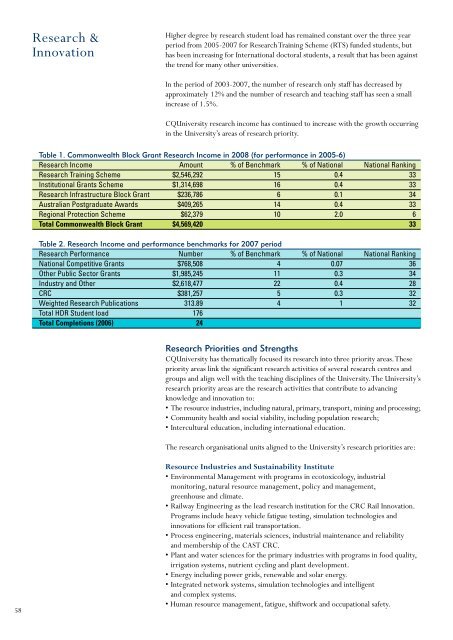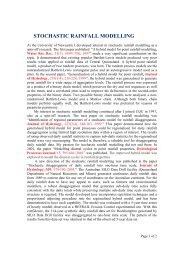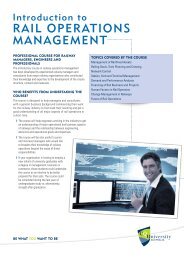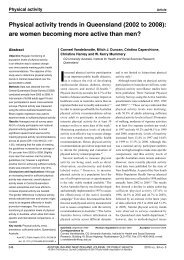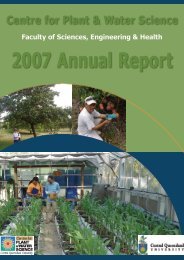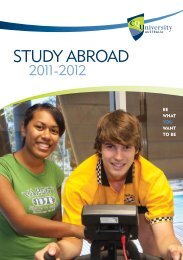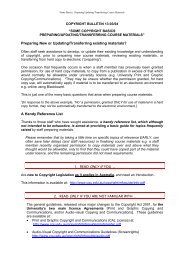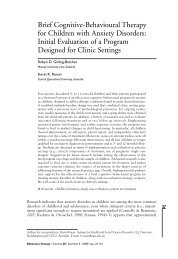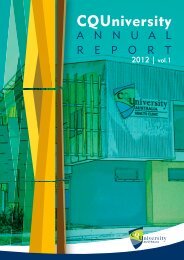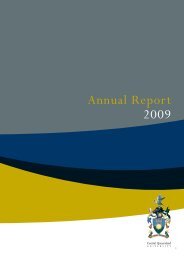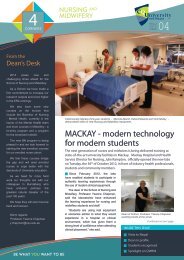Annual Report 2008 - Central Queensland University
Annual Report 2008 - Central Queensland University
Annual Report 2008 - Central Queensland University
Create successful ePaper yourself
Turn your PDF publications into a flip-book with our unique Google optimized e-Paper software.
Research &<br />
Innovation<br />
Higher degree by research student load has remained constant over the three year<br />
period from 2005-2007 for Research Training Scheme (RTS) funded students, but<br />
has been increasing for International doctoral students, a result that has been against<br />
the trend for many other universities.<br />
In the period of 2003-2007, the number of research only staff has decreased by<br />
approximately 12% and the number of research and teaching staff has seen a small<br />
increase of 1.5%.<br />
CQ<strong>University</strong> research income has continued to increase with the growth occurring<br />
in the <strong>University</strong>’s areas of research priority.<br />
Table 1. Commonwealth Block Grant Research Income in <strong>2008</strong> (for performance in 2005-6)<br />
Research Income Amount % of Benchmark % of National National Ranking<br />
Research Training Scheme $2,546,292 15 0.4 33<br />
Institutional Grants Scheme $1,314,698 16 0.4 33<br />
Research Infrastructure Block Grant $236,786 6 0.1 34<br />
Australian Postgraduate Awards $409,265 14 0.4 33<br />
Regional Protection Scheme $62,379 10 2.0 6<br />
Total Commonwealth Block Grant $4,569,420 33<br />
Table 2. Research Income and performance benchmarks for 2007 period<br />
Research Performance Number % of Benchmark % of National National Ranking<br />
National Competitive Grants $768,508 4 0.07 36<br />
Other Public Sector Grants $1,985,245 11 0.3 34<br />
Industry and Other $2,618,477 22 0.4 28<br />
CRC $381,257 5 0.3 32<br />
Weighted Research Publications 313.89 4 1 32<br />
Total HDR Student load 176<br />
Total Completions (2006) 24<br />
Research Priorities and Strengths<br />
CQ<strong>University</strong> has thematically focused its research into three priority areas. These<br />
priority areas link the significant research activities of several research centres and<br />
groups and align well with the teaching disciplines of the <strong>University</strong>. The <strong>University</strong>’s<br />
research priority areas are the research activities that contribute to advancing<br />
knowledge and innovation to:<br />
• The resource industries, including natural, primary, transport, mining and processing;<br />
• Community health and social viability, including population research;<br />
• Intercultural education, including international education.<br />
The research organisational units aligned to the <strong>University</strong>’s research priorities are:<br />
58<br />
Resource Industries and Sustainability Institute<br />
• Environmental Management with programs in ecotoxicology, industrial<br />
monitoring, natural resource management, policy and management,<br />
greenhouse and climate.<br />
• Railway Engineering as the lead research institution for the CRC Rail Innovation.<br />
Programs include heavy vehicle fatigue testing, simulation technologies and<br />
innovations for efficient rail transportation.<br />
• Process engineering, materials sciences, industrial maintenance and reliability<br />
and membership of the CAST CRC.<br />
• Plant and water sciences for the primary industries with programs in food quality,<br />
irrigation systems, nutrient cycling and plant development.<br />
• Energy including power grids, renewable and solar energy.<br />
• Integrated network systems, simulation technologies and intelligent<br />
and complex systems.<br />
• Human resource management, fatigue, shiftwork and occupational safety.


